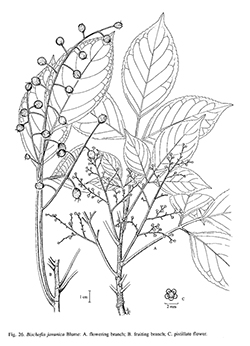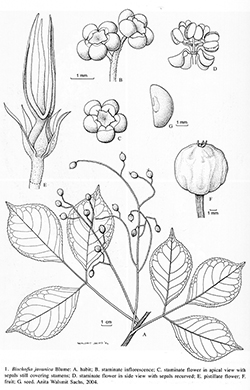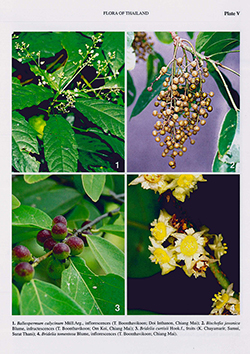e-Flora of Thailand
Volume 8 > Part 1 > Year 2005 > Page 124 > Euphorbiaceae > Bischofia
Bischofia javanica Blumewfo-0000342237
Bijdr. 17: 1168. 1826/27; Hook.f., Fl. Brit. Ind. 5: 345. 1887; Gagnep. in Lecomte, Fl. Indo-Chine 5: 542, fig. 66: 15–18; fig. 67: 6-9. 1927: Backer & Bakh.f., Fl. Java 1: 474. 1963. Fig. 26; Plate V: 2./ Appendix Fig. 1.
Accepted Name : This is currently accepted.
Synonyms & Citations :
Description : Tree up to 40 m high, dbh up to 2 m; buttresses often present; outer bark thin, slightly cracked to usually flaking with fibrous, thin strips or scaling, pale reddish to usually dark brown; inner bark pink to light reddish to cream inside, soft; sapwod white to light red, soft to hard; heartwood dark beefy red. Stipules ca 5 by 1.7 mm. Leaves 3-foliolate; petiole 5.5–16.5 cm long, petiolules up to 6.5 cm long, especially central one longer, blade mainly elliptic, 5–18 by 2.8–10 cm, length/width ratio 1.4–2.3, base cuneate, occasionally with two glandular teeth at point of petiole insertion on upper surface, apex acuminate, upper surface dark green, lower surface light green; nerves in 7–8 pairs. Inflorescences up to 32 cm long in fruit. Staminate flowers ca 2.5 mm in diam., red in bud, yellowish when open; pedicel ca 2.6 mm long; sepals almost circular, ca 1.2 by 1.1 mm, light green, apex rounded, slightly hairy; torus ca 0.5 mm high; filaments 0.5–0.6 mm long, light green; anthers ca 1 by 0.8 mm, yellow-green to light yellow. Pistillate flowers quickly developing into fruits; pedicel in fruit up to 11 mm long; sepals ovate, 2.1–4 by 0.8–1 mm, apex acute; staminodes up to ca 0.5 mm high; ovary green; style ca 0.7 mm long; stigmas 4.5-5 mm long, whitish. Fruits 8–10 by 7–10 mm, dark red to brown. Seeds ca 4.2 by 3.2 by 3 mm.
Thailand : NORTHERN: Chiang Mai (Ban Bing Kong, Ban Mae Sae, Doi Chiang Dao, Doi Pui, Doi Suthep, Fang, Mae Pa Bo), Chiang Rai (Muang Pua), Lampang (Doi Khun Tan); EASTERN: Nakhon Ratchasima (Khao Laem); SOUTH-WESTERN: Kanchanaburi (Huai Banhau, Koeng Chada); CENTRAL: Saraburi (Phu Khae); SOUTH-EASTERN: Chon Buri (Khao Khiao), Chanthaburi (Khao Soi Dao); PENINSULAR: Krabi (Khao Sato).
Distribution : India (Assam, Kerala), Bangladesh, China (Guangdong, Guizhou, Hainan, Hong Kong), Taiwan, Japan (Ryukyus), Malay Peninsula, Sumatra, Java (type), Borneo, the Philippines, Sulawesi, Lesser Sunda Islands, Maluku, New Guinea, Solomon Islands, E Australia, New Caledonia, Vanuatu, Fiji, Tonga, Cook Islands. Note the absence in Indochina (Laos, Cambodia, Vietnam).
Ecology : In many different habitats: primary wet evergreen to dry evergreen to deciduous to disturbed forests, beach forests, riparian forests, degraded scrub forests, thickets, village commons; usually in wetter places, often along streams, forests margins, roads; on sand, loam, clay, limestone, coral reef; sea level up to 1,000 (–2,350) m alt. Fruits eaten by Oriolus birds.
Vernacular : Toem (เติม)(Northern); du som (ดู่ส้ม)(Kanchanaburi, Nakhon Ratchasima).
Uses: Medicinal use in China (Hainan); fruits eaten in Borneo (Sarawak); wood used as firewood in New Guinea and for fencing (grows!) in the Solomon Islands; in the latter the squeezed bark or the latex is used as a brown or black dye.



